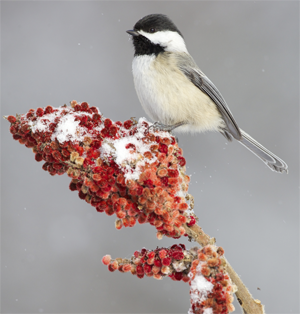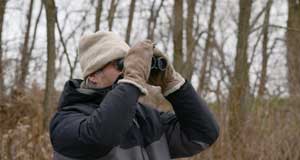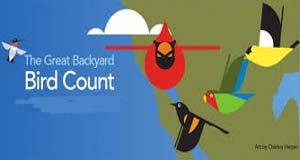
Black Capped Chickadee, Photo: Missy Mandel c/o Ontario Nature
Throughout the holiday season, many Ontarians enjoy one decadent feast after another. Why not burn off those newly-acquired calories by helping our feathered friends?
The Christmas Bird Count, initiated by American ornithologist Frank Chapman in 1900, is a one-day bird census conducted by volunteers. Counts are organized locally by birding and nature clubs. They are free and open to people of all ages and skill levels.
This year’s counts will run from December 14, 2016 to January 5, 2017. Visit the Bird Studies Canada (http://bsc-eoc.org/volunteer/cbc) and Ontario Nature (http://ontarionature.org/cbc) websites to find a count near you. Many of Ontario Nature’s member groups are coordinating counts across the province this season.

Bird Watcher, Photo: Roger Frost c/o Ontario Nature
Always fun and sometimes chilly, each volunteer who braves the elements to take part in a count contributes to the study and conservation of birds. Data collected are used to monitor the status of resident and migratory birds throughout the western hemisphere. The Christmas Bird Count is North America’s longest-running wildlife census, and is a crucial part of Canada’s biodiversity monitoring database.
“The Christmas Bird Count is a great way for bird lovers of all ages to help Ontario’s birds. Novices work alongside experts to collect important data that help guide our work on behalf of all birds across the province. And who knows… maybe you’ll see a rare bird that no one has recorded before,” says Emma Horrigan, Conservation Science Coordinator at Ontario Nature
Last year, 3,472 people participated in 120 Christmas Bird Counts in Ontario. A whopping 187 species and 1,559,310 individual birds were recorded. Here are some highlights:
Toronto had the most field observers (150). But Ottawa-Gateneau (133), Algonquin (110), Hamilton (107) and London (100) all cracked the 100 mark.
The five most commonly spotted birds last year were the Canada goose (261, 011), American crow (252,921), European starling (132,769), ring-billed gull (101,382) and mallard (89,797).
Other high counts include 203 red-necked grebes in Barrie and 10,870 tundra swans on the St. Clair National Wildlife Area count.
An unusually warm and ice-free December contributed to large year-over-year gains in sightings of a number of inland waterbirds, including hooded mergansers, buffleheads, common loons, common goldeneyes and Sandhill cranes.
124 snowy owls were recorded on 30 counts.
Swamp, white-throated, song, field, chipping and savannah sparrows were recorded in lower numbers than last year.
A vermilion flycatcher at Wallaceburg and a yellow-bellied flycatcher at Cedar Creek represented firsts among Canadian Christmas Bird Count records.
Other rare bird highlights include an American white pelican in Belleville, a black-throated gray warbler in Pembroke, a Bullock’s oriole on the Pakenham-Arnprior count and a Eurasian tree sparrow at Pike Bay.
What avian rarities and trends will we uncover this year? Join a Christmas Bird Count to find out. And if you’re still not convinced that participating in a count is for you, many are followed by a pot-luck meal.
For more information, please contact:
Lisa Richardson, Nature Network and Communications Coordinator, Ontario Nature: 416-444-8419 ext. 222; mailto:lisar@ontarionature.org
Ontario Nature protects wild species and wild spaces through conservation, education and public engagement. It connects thousands of individuals and communities with nature through close to 150 conservation groups, and 30,000 members and supporters across the province. For more information, visit ontarionature.org.
 TheBulletin.ca Journal of Downtown Toronto
TheBulletin.ca Journal of Downtown Toronto
